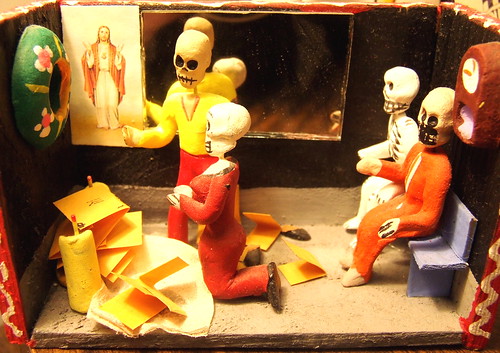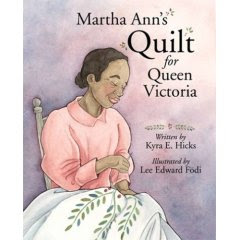These days I've been reviewing picture books over at
Book Buds or at
The Edge of the Forest. But once and awhile a picture book I really want to mention has already been reviewed on both sites. Such is the case with
Martha Ann's Quilt for Queen Victoria.Martha Ann's Quilt for Queen Victoria is the story of one woman's dream--a dream she held dear despite ridicule and the dismissal of her family and friends. Based on a true account,
Martha Ann's Quilt for Queen Victoria also chronicles this dream within the context of what can only be called a difficult life.
Martha Ann was born a slave in Tennessee. Her father began saving to buy the family's freedom and move to Liberia, where Martha Ann and her siblings could not only live as free people, but also attend school. Unfortunately, shortly after arriving to Liberia, African fever killed Martha Ann's parents and her sisters, leaving her with only her brothers. The small family survived and Martha Ann married. One day, Martha Ann read about Queen Victoria in the newspaper: "She admired Queen Victoria for trying to save her and others from slavery by sending the navy." Martha Ann resolves to meet Queen Victoria and thank her in person.
Martha Ann
began saving coins in the same red box her father used to collect monies for the move to Liberia. She also begins to make a gift for the queen--a beautiful quilt with a coffee tree design. Martha Ann survives gunfire at the hands of local tribesmen, the death of two husbands, and the taunts of local children: "Auntie Martha gonna see the Queen,/Stitching a quilt of coffee beans./How man stitches will it take?/Two-four-six-eight!"
Finally, when Martha Ann was in her 70s, the wife of Liberia's first president, Mrs. Jane Roberts, helps Martha Ann make the trip to present her quilt to Queen Victoria.
Martha Ann's life and dream comprise quite a story in and of themselves. But author
Kyra E. Hicks lends a majesty to the tale, with simple, heartfelt prose and a focus on the dream above all. Lee Edward
Fodi's illustrations perfectly accent this text--while realistic, they also have a childlike quality that emphasizes the prominence of the dream in the story.
Martha Ann's Quilt for Queen Victoria is best suited for children ages six to ten. Read it aloud to a second- to fourth-grade class: this story will change the way they think about the world and inspire them to hold on to their dreams.
=============================
Review copy received by the author.
Martha Ann resources:
A photo of Martha Ann Ricks in the National Portrait Gallery in London. The portrait was commissioned by Queen Victoria.
Kyra E. Hicks website, which includes a teaching guide for
Martha Ann's Quilt for Queen Victoria and information on African-American quilting.

 For this December issue I chose a deliciously funny teen vampire book as my Editor's Choice of the month. Sucks to be me: The All-True Confessions of Mina Hamilton, Teen Vampire (maybe) by Kimberly Pauley would make a great gift for a teen who has an appreciation for vampire tales. You can see my interview with the author of this entertaining book on the November 13th, 2008 blog entry.
For this December issue I chose a deliciously funny teen vampire book as my Editor's Choice of the month. Sucks to be me: The All-True Confessions of Mina Hamilton, Teen Vampire (maybe) by Kimberly Pauley would make a great gift for a teen who has an appreciation for vampire tales. You can see my interview with the author of this entertaining book on the November 13th, 2008 blog entry.












Wow. That book is beautiful.
Pretty, pretty illustrations!
You should see P.J. Lynch's version of A Christmas Carol - it's even better.
Oooh. I need this book. (And I should get the Christmas Carol, too. Our's is old and not illustrated. I need an illustrated one.)
Does Candlewick ever publish anything that isn't marvelous?
I've never read it, but that picture with the hair is awesome.